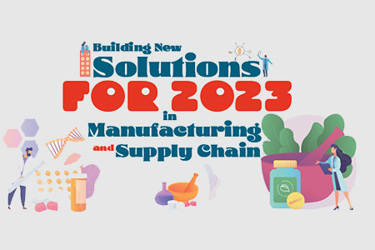2023 Manufacturing And Supply Chain Outlook: Additional Insights

By Ben Comer, Chief Editor, Life Science Leader

In an effort to provide a diversity of viewpoints on pressing questions related to biopharma manufacturing and supply chain in 2023, Life Science Leader reached far and wide in soliciting executive responses to questions featured in our December Industry Outlook 2023 special issue. We greatly appreciate the volume and quality of responses received from leaders across the industry, many of which appeared in the print magazine: those manufacturing and supply chain questions and responses can be found here. The following collection of responses did not appear in the December magazine, due to space constraints, and are presented here as an online supplement providing additional insights submitted in response to our outlook questions.
What existing or emerging technologies will most improve the biopharma manufacturing function in 2023?
 Gurinder Kaur
Gurinder Kaur
VP, Operations IT
AstraZeneca
It’s exciting to see artificial intelligence and machine learning, having been discussed for so long, are now coming to fruition and enabling the next level of digital maturity across biopharmaceutical manufacturing. Predictive capabilities, such as condition-based maintenance and process digital twins , are becoming a reality. Meanwhile, process analytical technologies mean that quality control and assurance can be built in to the manufacturing process itself. The benefits of this are not simply reduced costs but also tangible, significant improvements in supply chain system flexibility, productivity and crucially, sustainability.
However, the key to maximising the potential of artificial intelligence and machine learning is data. Biopharma manufacturing is increasingly complex and subject to rigorous quality and regulatory requirements that may differ by market. Historically, our existing processes, technologies and machinery were very localised and paper-driven, making data collection and analysis a laborious, time-consuming activity. As an industry we are now seeing a seismic shift in that approach. Companies are rapidly adopting enterprise standard processes and platforms.
That is why, in my view, it is those existing technologies which deliver data standardisation and digitization that will most improve the biopharma manufacturing function in 2023. Technologies such as data historians and manufacturing execution systems, combined with advanced and predictive analytics capabilities as well as architectural approaches such as data mesh, will expand access to robust, reliable data across all organisational levels. That capability will enable faster, more informed decision making that will drive our future supply chains.
Do you anticipate increasing consolidation in the CDMO sector next year? If so, what are the potential implications for drug sponsors?
 James Mackay
James Mackay
President and CEO
Aristea Therapeutics
Over the past few years, we have seen significant consolidation of the CRO industry with important mega-mergers of global CROs players and also significant activity in consolidating niche CRO providers. Much of this has been driven by strong fundamentals in the outsourcing industry with both large pharma and biotechs becoming more and more reliant on outsourced partners. As a result, private equity investors have invested significant funds in this sector. I expect that we will see increased activity like this in the CDMO space in 2023, as private equity investors embrace the strong fundamentals of the CDMO market and put money to work in this area, driving consolidation where it makes sense. One area that I think is very interesting to watch are the providers, such as AltaSciences, that are developing a one-stop-shop approach to pre-clinical CRO, bioanalytical, clinical CRO and CDMO capabilities. I see this approach becoming more and more interesting to the biotech industry as it has the potential to create a true extension of the biotech team into the CRO/CDMO. If this can be achieved effectively and efficiently, it could lead to a game changing model.
What are the biggest manufacturing challenges the biopharma industry is likely to face in 2023, and how can companies work – or innovate – to overcome these challenges?
 Andrew Wirths
Andrew Wirths
SVP, Americas Supply
AstraZeneca
One of our main industry challenges is addressing the increased volatility we are experiencing across our end-to-end supply chains, from our suppliers to our customers. Is it unclear when we will see a “return to normal” or any return to pre-pandemic stable conditions. Instead, we are facing increased volatility with supply chain disruptions, labor shortages, vendor delays, and inflation. These require us to maintain the lessons we learned throughout the pandemic and ensure they are embedded in our ways of working moving forward. We will need to retain or enhance the same agility, the same speed, and the same mindset that had to be developed during the height of the pandemic to respond to these disruptors. At AstraZeneca, we remain focused on embracing our lean and digital transformation which enhances our end-to-end agility, drives productivity, empowers our people and supports our sustainability ambition. But ultimately our success is underpinned by our people, which is why we are committed to their life-long development and ensuring every person everyday can contribute to their fullest.
